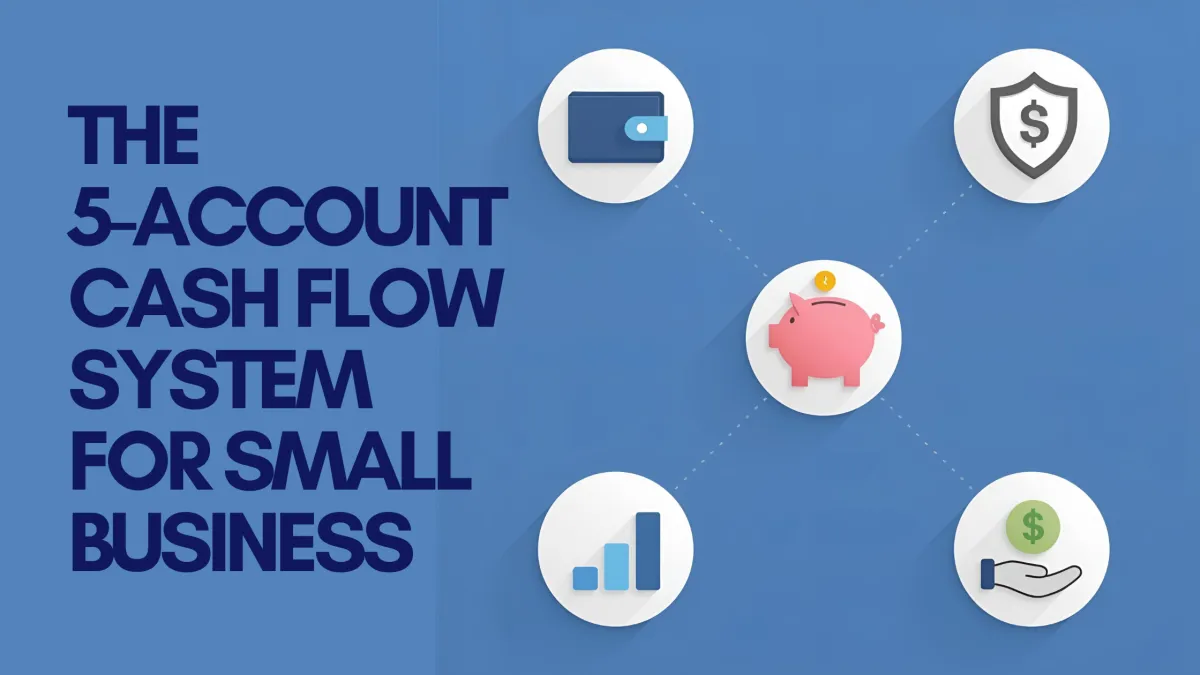
5- Account Cash Flow System
The 5-Account Cash Flow System Every Small Business Owner Needs
How to Finally Take Home a Consistent Paycheck Without Starving Your Business
If you’ve ever looked at your bank balance and wondered, “Where did all the money go?” you’re not alone.
Most small business owners I work with fall into one of two traps:
They either starve themselves—pouring every dollar back into the business—or they starve the business by pulling too much cash out too soon.
Neither is sustainable.
That’s why I want to share a simple system inspired by one of my favorite frameworks, the 5-Account Cash Flow Waterfall, originally taught by Ryan Deiss. I’ve adapted it over time to fit the real-life needs of brick-and-mortar and service-based businesses that want to profit intentionally—not accidentally.
This cash flow framework is one of the key tools inside the Results Driver of my Smart Growth System™, because when it comes to business growth, results only come from what’s measured, tracked, and managed—especially your money.
Why This Matters
Healthy cash flow is the heartbeat of your business.
Without a system, money leaks happen quietly—small overspending, delayed taxes, surprise expenses, and inconsistent paydays.
But with structure in place, you’ll always know:
What’s safe to spend
What is set aside for taxes
What’s available for growth
And most importantly… what is yours to take home
So let’s walk through the 5 accounts that bring calm and clarity to your cash flow.
1. Operating Account – Your Everyday Checking
Think of this as your business’s heartbeat.
This account handles all your regular expenses—payroll, rent, vendors, subscriptions, and advertising.
Here’s the rule: keep just one month of total operating expenses in this account.
Anything more becomes temptation money—and business owners are pros at finding new ways to spend it.
At the end of the month, whatever’s left over will be transferred into your next accounts.
2. Tax Savings Account—Your Sanity Protector
Tax surprises are profit killers.
Every month, move 30% of your net profit into a separate tax account.
This money is untouchable—essentially, I want you to pretend it doesn’t exist.
Your future self (and your accountant) will thank you when April rolls around.
3. Emergency Fund—Your Peace of Mind
Imagine three slow months in a row. Could your business still function?
That’s where your emergency fund comes in.
Set aside enough to cover three months of fixed expenses—payroll, rent, and utilities.
This isn’t an investment account; it’s a safety net.
And once you’ve hit your 3-month goal, consider expanding to 6 months based on your risk tolerance.
4. Future Investment Funds—Your Growth Engine
Big expenses shouldn’t feel like surprises.
Think new equipment, marketing campaigns, or hiring plans.
Each major goal gets its own “sinking fund.”
By setting money aside gradually, you’ll never need to drain your operating cash or take on unnecessary debt to grow.
5. Distribution Account—Your Reward
This is your “I built this” account.
Once the other four accounts are funded, any overflow lands here.
Every quarter, distribute 80% to yourself and leave 20% as a cushion.
It’s your well-deserved reward for running a real business—not just a stressful job that pays everyone but you.
Putting It All Together
When I help clients implement their Results Driver inside their Smart Growth System™, this is one of the first habits we install.
Because when your cash has a plan, your business has power.
✅ You can make smarter decisions.
✅ You stop chasing deposits.
✅ You build stability and profit—intentionally.
If your cash flow feels chaotic or you’re not sure how to get started with this system, I can help you map it out step-by-step and customize it for your business size and goals.
Ready to Finally Pay Yourself Without Guilt?
Let’s take the guesswork out of your numbers.
Book a free Smart Growth Strategy Session and we’ll walk through your current cash flow together—then design a plan that gets you out of survival mode and back into profit mode.